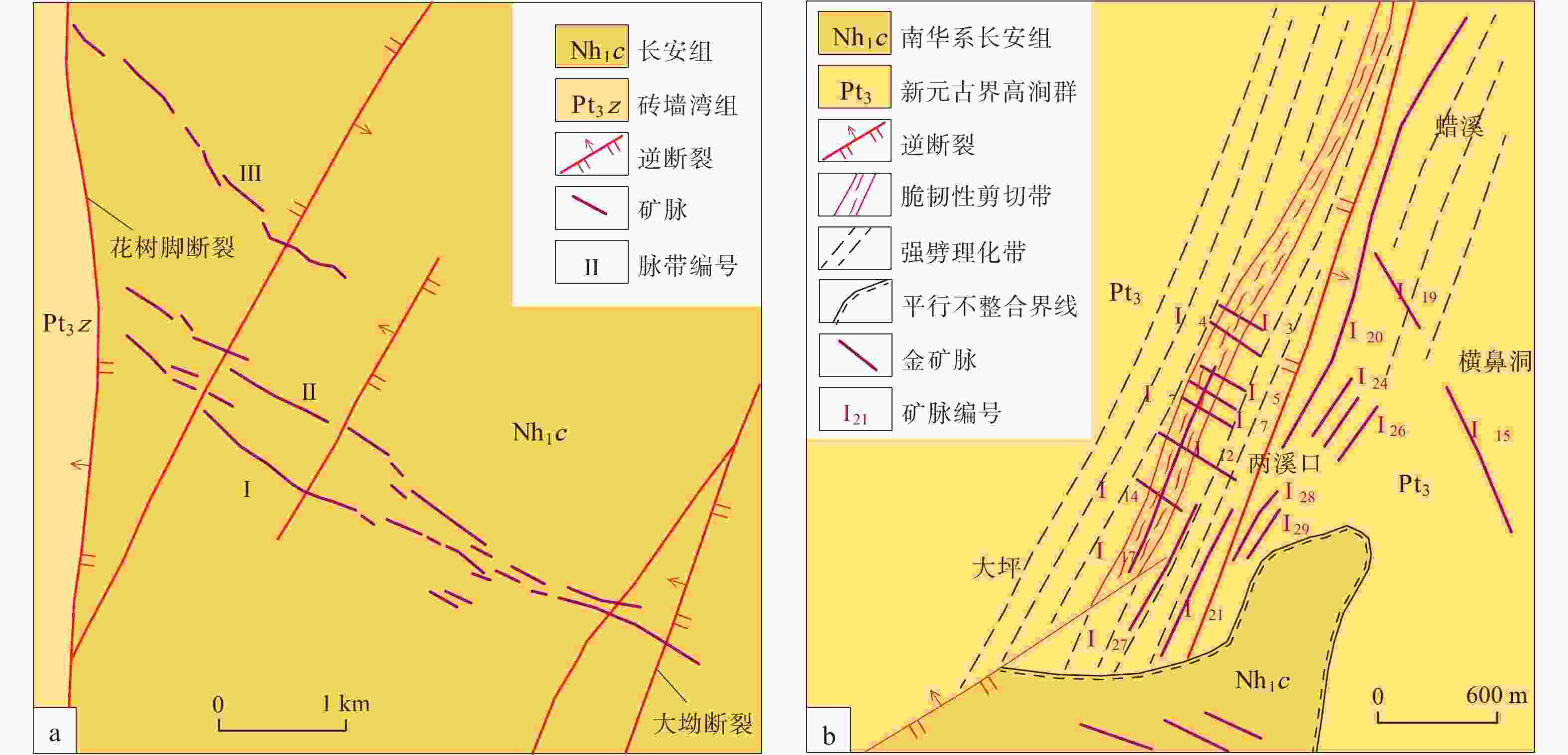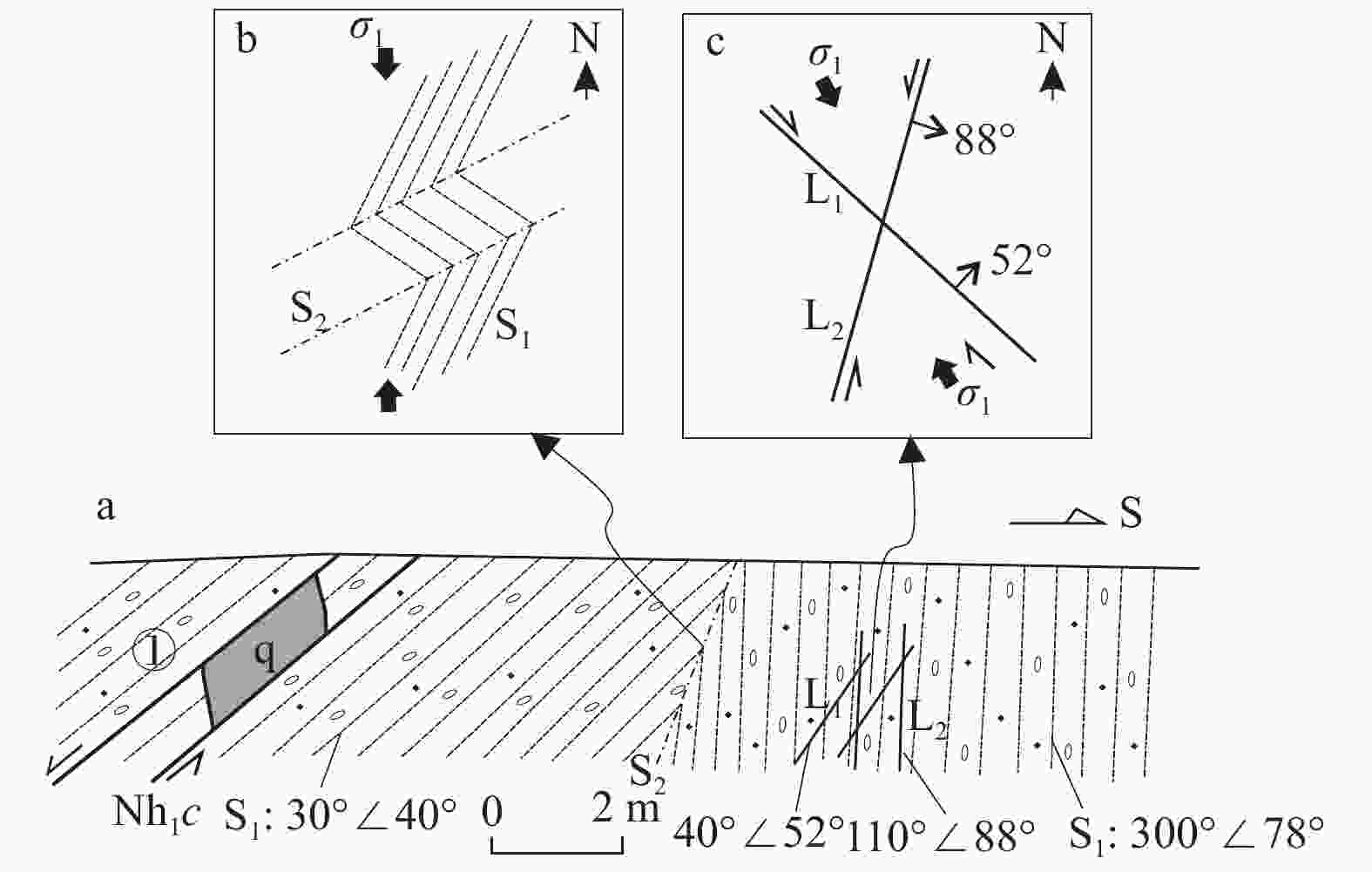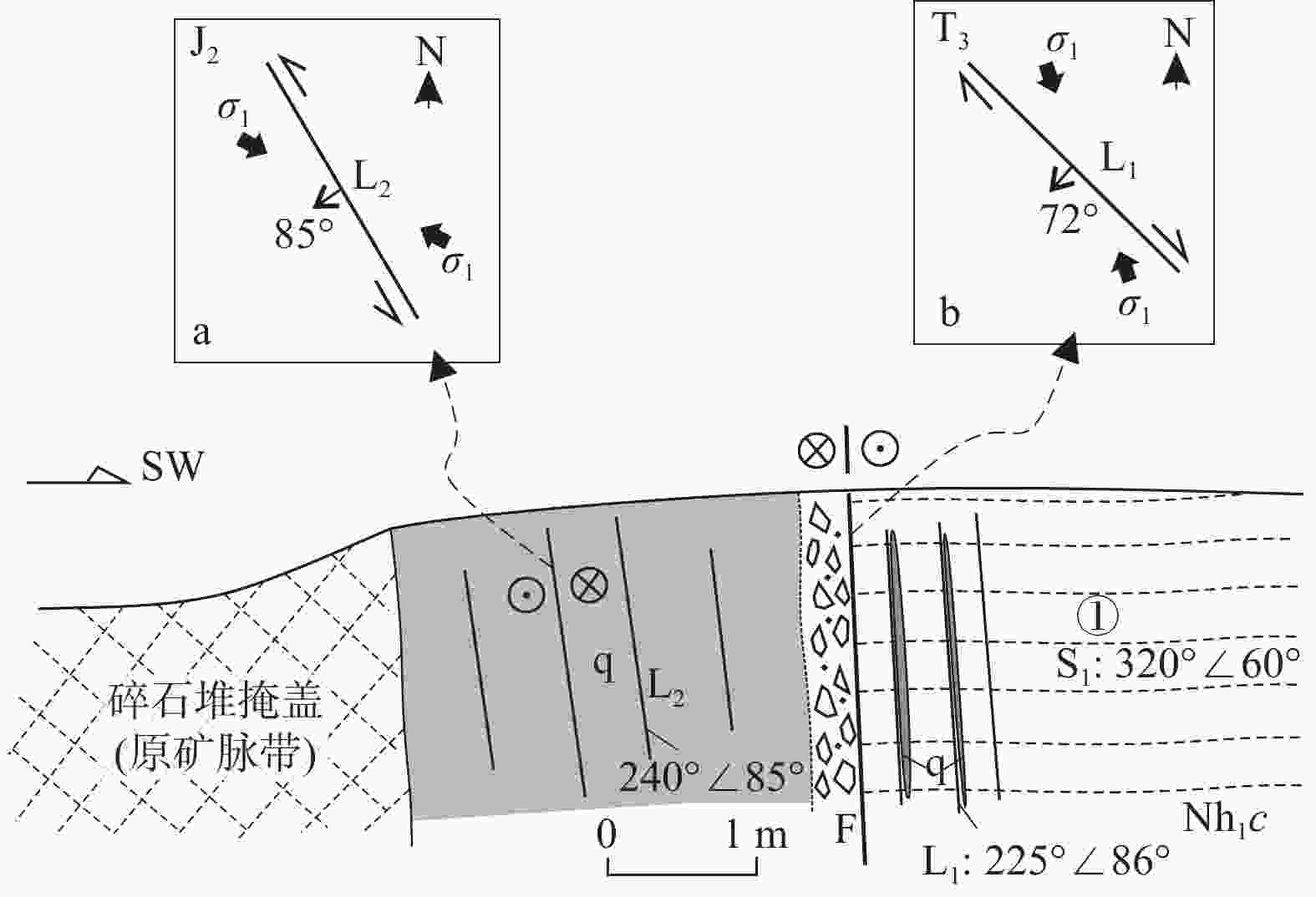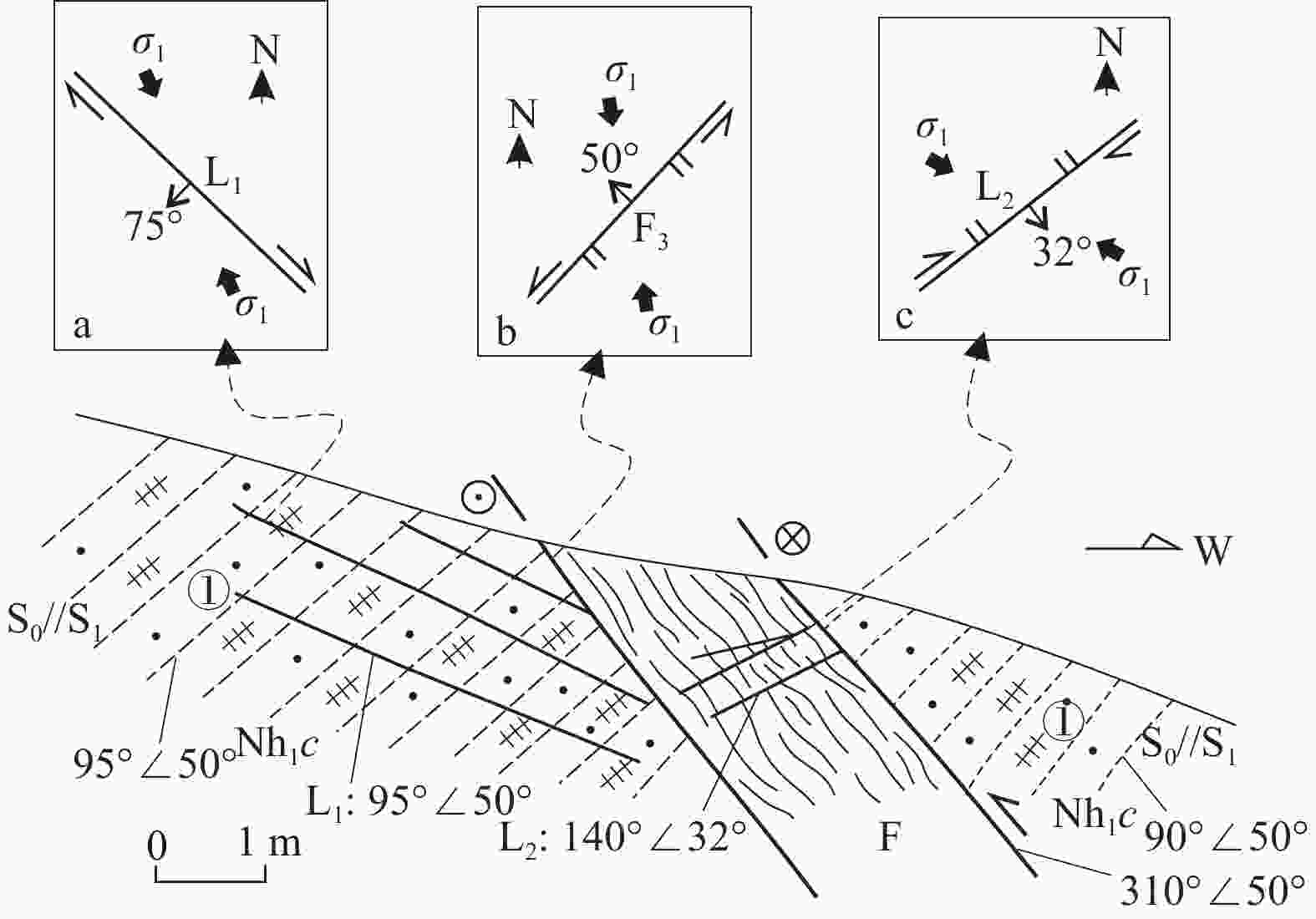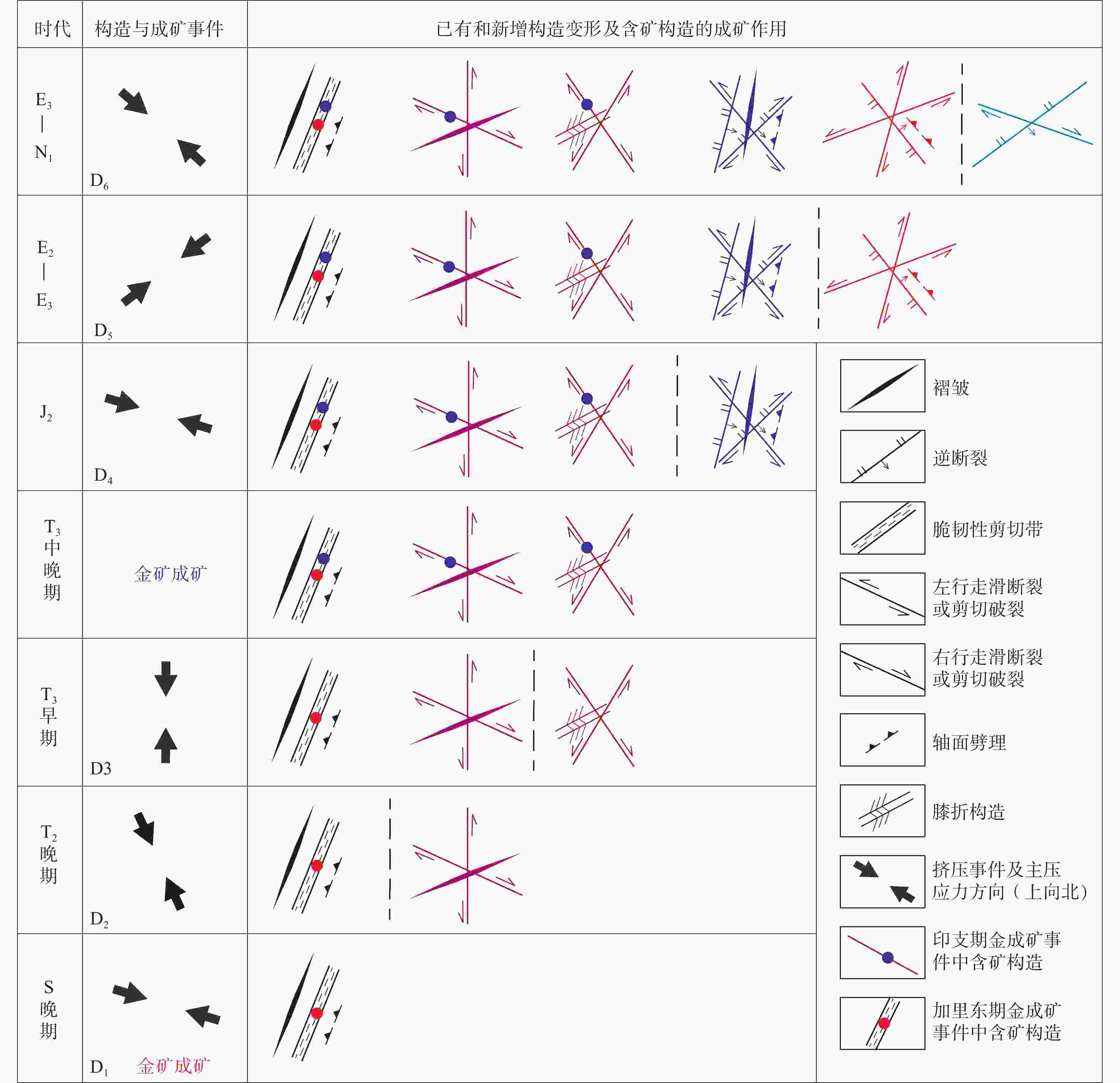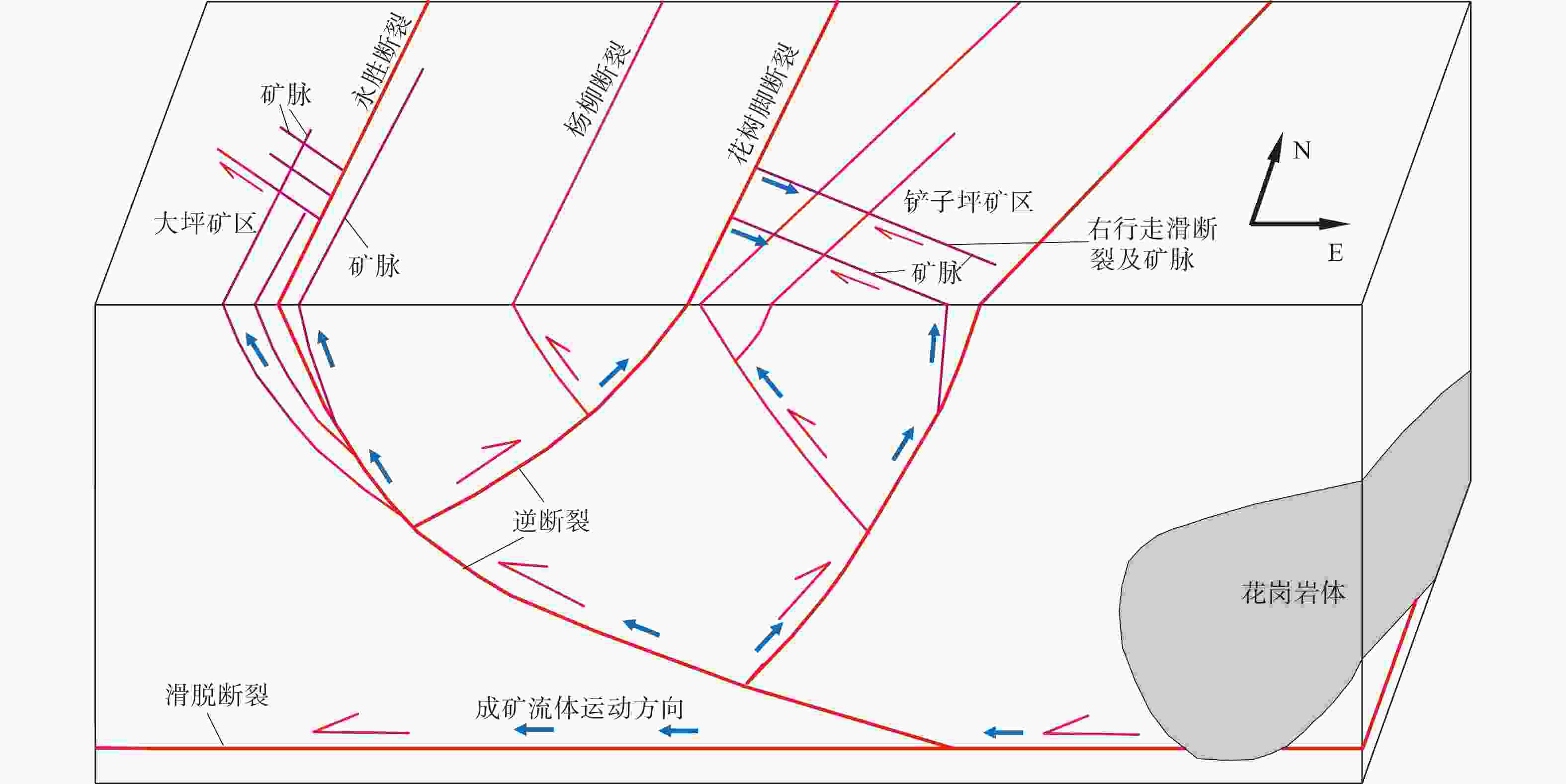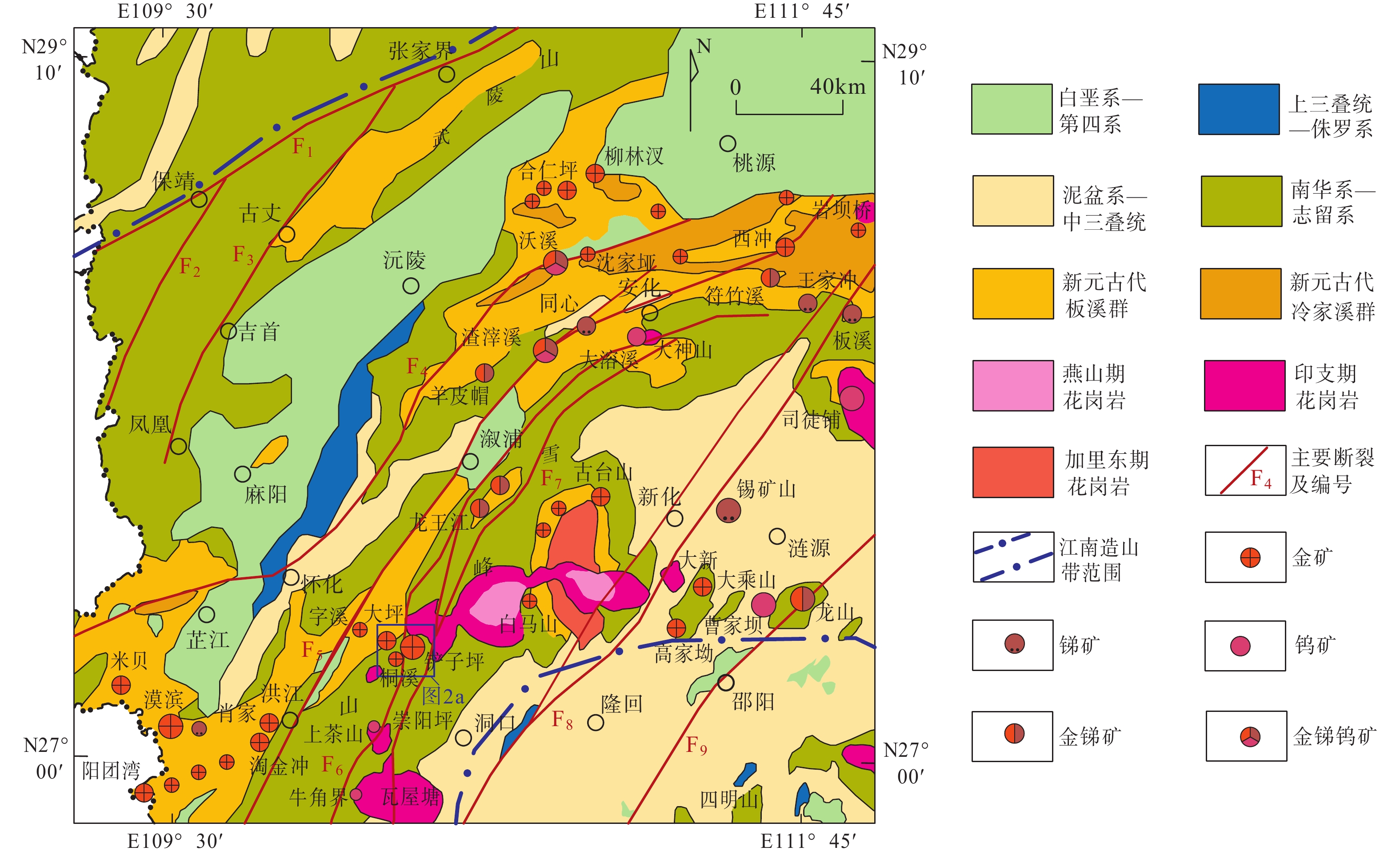Deformation sequences and ore-controlling structures of the Chanziping–Daping gold mining area in Hunan Province, China
-
摘要: 湖南铲子坪−大坪金矿区位于雪峰弧形构造带西南段,金矿脉主要呈北西西向—北北西向,其次为北北东向。尽管现有研究表明北东向断裂为导矿和容矿构造、北西向断裂为容矿构造,但对控矿断裂的性质和形成时代缺乏明确可靠的认识。文章根据对地表露头构造和矿化蚀变的观测、解析,结合区域构造特征、构造演化和测年资料等,厘定了铲子坪−大坪金矿区构造变形序列及其时代背景,确定了控矿构造类型及其属性。研究认为,研究区自早至晚经历了6期主要变形事件:志留纪晚期受到北西西向挤压,形成北北东走向的褶皱、板劈理和脆韧性剪切带;中三叠世晚期受到北北西向挤压,形成北西西向—北西向右行走滑断裂和剪切破裂、南北向左行剪切破裂、北西向和北北东向共轭剪切破裂、北东东向的逆断裂和叠加褶皱;晚三叠世早期受到南北向挤压,形成北西向—北北西向右行走滑断裂和剪切破裂、北北东向—北东向左行剪切破裂和断裂、北东东向左行膝折构造;中侏罗世晚期受到北西西—近东西向挤压,形成南北向—北北东向逆断裂、北西向—北西西向左行剪切破裂、北东向右行逆冲剪切破裂、北北东向—近南北向的破劈理、面理褶皱和石香肠;古近纪中晚期受到北东向挤压,形成北北东向—南北向右行剪切破裂和断裂、北东东向左行剪切破裂、北西向的逆断裂和破劈理;古近纪晚期—新近纪初期受到北西向挤压,形成北东向逆冲剪切破裂、北西西向右行剪切破裂。研究区北北东向矿脉形成于志留纪晚期和晚三叠世,北西西向—北北西向矿脉形成于晚三叠世晚期。志留纪晚期成矿与断裂运动导致的构造活化作用有关,晚三叠世晚期成矿与同期大规模花岗质岩浆活动有关。导矿构造主要为志留纪晚期北西西向挤压形成的北北东向大断裂即脆韧性剪切带。主要容矿构造为中三叠世晚期北北西向挤压形成的北西西向—北西向右行走滑断裂、晚三叠世早期南北向挤压形成的北西向—北北西向右行走滑断裂,其次为志留纪晚期北西西向挤压形成的北北东向脆韧性剪切带。Abstract: The Chanziping–Daping gold deposit area is located in the southwest section of the Xuefeng arc-shaped structural belt, with mainly NWW-NNW-trending and secondary NNE-trending Au veins. Existing studies proposed the NE-trending faults as the ore-passing and ore-bearing structures and the NW-trending faults as the ore-bearing structures. However, there is no clear and reliable understanding of the nature and age of ore-controlling faults. Given this, the authors carried out detailed field observation and analysis of surface outcrop structures and mineralization alteration, and then combined with regional structural characteristics, tectonic evolutions, and dating data, determined the deformation sequences and their ages in the Chanziping–Daping gold deposit area, and determined the types and attributes of ore-controlling structures. The study suggests that the study area experienced six main deformation events from early to late: Regional NWW compression during the late Silurian which resulted in the NNE-trending folds, slaty cleavages and brittle-ductile shear zones; Regional NNW compression in the late Middle Triassic which caused the formation of NWW-to-NW-trending dextral strike-slip faults and shear fractures, NS-trending sinistral shear fractures, NW- and NNE-trending conjugate shear fractures, NEE-trending thrust faults and superimposed folds; Regional NS compression in the early Late Triassic which led to the development of NW-to-NNW-trending dextral strike-slip faults and shear fractures, NNE-to-NE-trending sinistral shear fractures and faults, and NEE-trending sinistral kinks; Regional NWW-to-near EW-compression in the late Middle Jurassic which resulted in the NS-to-NNE-trending thrust faults, NW-to-NWW-trending sinistral shear fractures, NE-trending dextral thrust shear fracture, NNE-to-near NS-trending fracture cleavages, foliation folds and boudins; Regional NE compression in the middle-late Paleogene which led to the development of NNE-to-NS-trending dextral shear fractures and faults, NEE-trending sinistral shear fractures, NW-trending thrust faults and fracture cleavages; Regional NW compression during the late Paleogene to early Neogene which led to the formation of NE-trending thrust shear fractures and NWW-trending dextral shear fractures. The NNE-trending mineral veins in the study area formed in the late Silurian and the late Late Triassic, and the NWW-to-NNW-trending mineral veins formed in the late Late Triassic. The mineralization in the late Silurian was associated with the tectonic activation caused by the fault movement, and the mineralization in the late Late Triassic was related to large-scale granitic magmatism in the same period. The ore-passing structures are mainly the large NNE-trending faults, namely the brittle-ductile shear zones formed by NWW- compression in the late Silurian. The main ore-bearing structures are the NWW-to-NW-trending dextral strike-slip faults formed by NNW compression in the late Middle Triassic, NW-to-NNW-trending dextral strike-slip faults formed by NS compression in the early Late Triassic, with next NNE-trending brittle-ductile shear zones formed by NWW compression in the late Silurian.
-
图 1 区域地质及锑−钨−金矿床分布图(据柏道远等,2021a修改)
F1—慈利−保靖断裂(江南断裂);F2—保靖−铜仁断裂;F3—古丈−吉首断裂;F4—怀化−沃溪断裂;F5—溆浦−靖州断裂;F6—通道−江口断裂;F7—城步−江口断裂;F8—城步−新化断裂;F9—公田−灰汤−新宁断裂
Figure 1. Regional geological map and distribution of Sb-W-Au deposits(modified after Bai et al., 2021a)
F1–Cili–Baojing fault (Jiangnan fault); F2–Baojing–Tongren fault; F3–Guzhang–Jishou fault; F4–Huaihua–Woxi fault; F5–Xupu–Jingzhou fault; F6–Tongdao–Jiangkou fault; F7–Chengbu–Jiangkou fault; F8–Chengbu–Xinhua fault; F9–Gongtian–Huitang–Xinning fault
图 2 铲子坪−大坪金矿区地质图及观察点上构造形迹与应力场方位
f1—芙蓉溪向斜;f2—大坪背斜;f3—青山洞向斜;f4—砖墙湾背斜;F1—母溪断裂;F2—公平断裂;F3—永胜断裂;F4—大坪断裂;F5—杨柳断裂;F6—花树脚断裂;F7—界脚断裂;F8—大坳断裂;F9—里木冲断裂;F10—断坑断裂;F11—响溪断裂;F12—塘湾断裂(a)铲子坪−大坪金矿区地质图;(b)观察点上构造形迹与应力场方位
Figure 2. Regional geological map of the Chanziping–Daping gold mining area and deformations and stress orientations on observation points
(a) Regional geological map of the Chanziping–Daping gold mining area (modified from 1∶50 000 Tieposhan Sheet Map, Tangwan Sheet Map and 1∶250000 Huaihua Sheet Map); (b) Deformations and stress orientations on observation pointsf1–Furongxi syncline; f2–Daping anticline; f3–Qingshandong syncline; f4–Zhuanqiangwan anticline; F1–Muxi fault; F2–Gongping fault; F3–Yongsheng fault; F4–Daping fault; F5–Yangliu fault; F6–Huashujiao fault; F7–Jiejiao fault; F8–Da’ao fault; F9–Limuchong fault; F10–Duankeng fault; F11–Xiangxi fault; F12–Tangwan fault
图 3 铲子坪金矿区和大坪金矿区地质图
a—铲子坪金矿区地质图(据骆学全,1996a修改);b—大坪金矿区地质图(据李华芹等,2008修改)
Figure 3. Geological map of the Chanziping gold mining area and the daping gold mining area
(a) Geological map of the Chanziping gold mining area (modified after Luo, 1996a); (b) Geological map of the Daping gold mining area (modified after Li et al., 2008)
图 4 代表性露头观察点走滑、斜滑剪切破裂和断裂的应力解析
发育多个裂面时,产状取走向和倾向的加权平均值
Figure 4. Stress analysis for strike-slip and oblique-slip shear fractures and faults at representative outcrop points
When multiple fractures are developed, the structural attitude is determined by the weighted average of dip direction and dip angle.
图 5 D501、D503及D504点构造特征
a—D501点处北西西向剪切破裂L1与南北向剪切破裂L2;b—D501点处反阶步及正阶步分别显示北西西向剪切破裂L1早期右行与晚期左行走滑;c—D501点处正阶步及反阶步分别显示南北向剪切破裂L2早期左行与晚期右行走滑;d—D501点处共轭剪切破裂L2左行切错并限制破裂L1;e—D503点处北西西向面理;f—D503点处北北东向面理及变形强弱分带;g—D504点处层理与劈理;h—D504点处北西向剪切破裂L1及石英脉;i—D504点北西倾剪切破裂L3切入北西向剪切破裂L1中石英脉;j—D504点处正阶步指示破裂L2左行走滑;k—D504点处次级羽裂指示北西倾剪切破裂L3逆冲;l—D504点北西西向剪切破裂L4右行切错北北东向剪切破裂L2;m—D504点处正阶步指示北西西向剪切破裂L4右行走滑;n—D504点近南北向剪切破裂L5右行切错北西向剪切破裂L1;o—D504点北北东向脆韧性剪切带中剪切面理(俯视);p—D504点处北北东向脆韧性剪切带中S-C组构显示西盘上升(垂向剖面)
Figure 5. Characteristics of structures at D501, D503 and D504
(a) NWW-trending shear fracture L1 and SN-trending shear fracture L2 at D501; (b) Antisteps and steps indicate that the NWW-trending shear fracture L1 at D501 dextrally sheared early and sinistrally sheared later respectively; (c) Steps and antisteps indicate that the SN-trending fracture L2 at D501 sinistrally sheared early and dextral sheared later respectively; (d) Conjugate L2 sinistrally cuts and restricts L1 at D501; (e) NWW-trending structural foliation at D503; (f) NNE-trending structural foliation and strong–weak deformation zoning at D503; (g) Stratification and cleavages at D504; (h) NW-trending shear fracture L1 and quartz veins at D504; (i) NW-dipping shear fracture L3 cut the quartz vein in NW-trending shear fracture L1; (j) Steps indicate sinistral slip for L2 at D504; (k) Secondary pinnate fractures indicate the thrust of NW-dipping shear fracture L3 at D504; (l) NWW-trending shear fracture L4 at D504 dextrally cuts NNE-trending shear fracture L2; (m) Steps at D504 indicate dextral slip for NWW-trending fracture L4 ; (n) Nearly SN-trending shear fracture L5 at D504 dextrally cut NW-trending shear fracture L1; (o) The shear foliation at D504 in NNE-trending brittle-ductile shear zone (overlook); (p) S-C fabric in the NNE-trending brittle-ductile shear zone at D504 indicate upward movement of the western wall rises (vertical section)
图 6 D503劈理和剪切破裂
①—含砾砂质板岩;Nh1 c —南华系长安组;L1—剪切破裂编号;S1—板劈理;S2—膝折面; σ 1—最大主应力a—露头剖面;b—北东东向左行膝折反映南北向最大主压应力;c—共轭剪切破裂反映北北西向最大主压应力
Figure 6. Cleavages and shear fractures at D503
(a) Outcrop profile; (b) NEE-trending sinistral kink zone indicate SN-compression; (c) Conjugated shear fractures indicate NNW compression ①–gravel-bearing sandy slate; Nh1 c –Nanhuan Chang’an Formation; L1–fractures and their numbers; S1–slaty cleavage; S2–axials of kink; σ1–maximum principal stress
图 7 D504点处断裂与多期剪切破裂
①—板岩;②—砂岩;Pt3 y —高涧群岩门寨组;L1—剪切破裂编号;S1—劈理; σ 1—最大主应力a—北东向劈理反映北西向最大主压应力;b—北西向右行剪切破裂反映南北向最大主压应力;c—北北东向左行剪切破裂反映南北向最大主压应力;d—北东向逆断裂和北西西向右行剪切破裂反映北西向最大主压应力;e—近南北向右行剪切破裂反映北东向最大主压应力
Figure 7. Fault and multiple sets of shear fractures at D504
(a) NE-trending cleavages indicate NW compression; (b) NW-trending dextral shear fractures indicate SN compression; (c) NNE-trending sinistral shear fractures indicate SN compression; (d) NE-trending thrust fault and NWW-trending dextral shear fractures indicate NW compression; (e) SN-trending dextral shear fractures indicate NE compression ①–slate; ②–sandstone; Pt3 y –Yanmenzhai Formation of Gaojian Group; L1–fractures and their numbers; S1–cleavages; σ 1–maximum principal stress
图 8 D505点构造特征
①—劈理化板岩; Pt3 z —高涧群砖墙湾组;L—剪切破裂;S1—劈理及编号;F1—断裂及编号; σ 1—最大主应力;β—褶皱枢纽;q—石英脉a—北东向左行剪切破裂反映近南北向最大主压应力;b—北西向逆断裂反映北东向最大主压应力;c—晚期北北西向破劈理产状;d—北北东向逆断裂反映北西西向最大主压应力;e—北北东向逆断裂反映北西西向最大主压应力;f—北北西向劈理产状
Figure 8. Characteristics of deformation at D505
(a) NE-trending sinistral shear fractures indicate SN compression; (b) NW-trending thrust fault indicate NE compression; (c) Attitudes of the later NNW-trending fracture cleavages; (d) NNE-trending thrust fault indicate NWW compression; (e) NNE-trending thrust fault indicate NWW compression; (f) Attitudes of the NNW-trending cleavages ①–cleavage slate; Pt3 z –Zhuanqiangwan Formation of Gaojian Group; L–shear fractures; S1–cleavages and their numbers; σ 1–maximum principal stress; β–hinge of fold; q–quartz vein
图 9 D505、D506点处构造特征
部分图中的圆圈指示运动学标志发育部位a—D505点处近南北向西倾逆断裂F1;b—D505点处西倾逆断裂F1下盘剪切面理褶皱;c—D505点处北北东向逆断裂F2下盘顺面理石英脉;d—D505点处北北东向东倾逆断裂;e—D505点处北西向早期板劈理与晚期破劈理;f—D505点处北西向逆断裂F3及上盘剪切褶皱;g—D505点处南北向破劈理;h—D505点处北东向剪切破裂面上正、反阶步显示左行;i—D505点处南北向劈理褶皱;j—D505点处南北向破劈理切割北西向板劈理;k—D506点处北北东向强劈理化带(剪切带)与北北东向右行逆断裂;l—D506点处正阶步显示北北东向断裂右行逆冲;m—D506点处正阶步及擦痕指示北西向剪切破裂L1右行;n—D506点处正阶步指示北北西向剪切破裂L2右行;o—D506点北北西向剪切破裂L2右行切错北西向剪切破裂L1(俯视)
Figure 9. Characteristics of structures at D505 and D506
(a) Nearly SN-trending and W-dipping thrust fault F1 at D505; (b) Shear foliation folds at D505 in the footwall of the W-dipping thrust fault F1; (c) Quartz veins at D505 along foliation in the footwall of the NNE-trending thrust fault F2; (d) NNE-trending E-dipping thrust fault at D505; (e) NW-trending early slaty cleavages and later fracture cleavages at D505; (f) NW-trending thrust fault at D505 and shear folds in the hanging wall; (g) SN-trending fracture cleavages at D505; (h) Steps and antisteps indicate that the NE-trending fractures at D505 sinistrally shear; (i) SN-trending cleavage folds at D505; (j) SN-trending fracture cleavages at D505 cut NW-trending slate cleavages; (k) NNE-trending strong cleavage zone (shear zone) and NNE-trending dextral strike-slip-thrust fault at D506; (l) Steps indicate that the NNE-trending fault at D506 dextrally strike-slip-thrust; (m) Steps and striations indicate the NW-trending fracture L1 at D506 dextrally shear; (n) Steps indicate that the NNW-trending fracture L2 at D506 dextrally shear; (o) NNW-trending shear fracture L2 at D506 cut and dextrally move NW-trending fracture L1 (overlook) Circles in some figures indicate the position of kinematics markers.
图 10 D506点处构造特征
①—强劈理化带;②—弱劈理化带;Nh1c—南华系长安组;L1—剪切破裂编号;S1—劈理及编号;F—断裂;σ1—最大主应力a—北北东向右行平移逆断裂反映北东向最大主压应力;b—北西向右行剪切破裂反映北北西向最大主压应力;c—北北西向右行剪切破裂反映南北向最大主压应力
Figure 10. Characteristics of deformation at D506
(a) NNE-trending dextral strike-slip thrust fault indicate NE compression; (b) NW-trending dextral shear fractures indicate NNW compression; (c) NNW-trending dextra shear fractures indicate SN compression ①–strong silicified zone; ②–weak silicified zone; Nh1c–Nanhuan Chang’an Formation; L1–fractures and their number; S1–cleavages; σ1–maximum principal stress
图 11 D507—D511点处构造特征
a—D507点处北西向断裂南西盘北东向剪切破裂及北东向劈理;b—D507点处北西向剪切破裂派生羽裂示右行走滑(斜俯视);c—D508点处强硅化带Ⅰ带顺层石英脉因挤压形成石香肠;d—D508点处强硅化带1带中羽裂指示北东东向剪切破裂左行(斜俯视);e—D508点处无硅化带Ⅱ带特征;f—D508点处强硅化带Ⅲ带中面理及顺层脉背斜;g—D508点处强硅化带Ⅴ带中背斜及核部石英脉;h—D508点处强硅化带Ⅴ带中板劈理S1与破劈理S2;i—D508点处弱硅化带Ⅵ带中劈理;j—D509点处强劈理化带中所夹脆韧性剪切带;k—D510点处北东向断裂及北西向剪切破裂L1、北东向剪切破裂L2;l—D510点处正阶步示北西向剪切破裂L1右行;m—D510点处正阶步及擦痕指示NW向断裂左行逆平移;n—D510点处后期NE向SE倾斜剪切破裂L2切割NE向次级断裂面;羽裂示L2右行逆冲;o—D511点处北北东向剪切破裂L2右行错移北西向剪切破裂L1
Figure 11. Characteristics of structures at D507—D511
(a) NW-trending shear fracture and NE-trending cleavages in the southwestern wall of the NW-trending fault at D507; (b) Secondary pinnate fractures indicate that NW-trending fracture at D507 dextrally shear (oblique overlook); (c) Bedding quartz veins in the strong silicified zone Ⅰ at D508 forms boudins under compression; (d) Pinnate fractures indicate that NEE-trending fractures in the strong silicified zone Ⅰat D508 sinistrally shear (oblique overlook); (e) Characteristics of the non-silicified zone Ⅱ at D508; (f) Structural foliation and bedding quartz vein anticline in the strong silicified zone Ⅲ at D508; (g) Anticline and quartz vein in the strong silicified zone Ⅴ at D508; (h) Slate cleavages S1 and fracture cleavages S2 in the strong silicified zone Ⅴ at D508; (i) Cleavages in the weak silicified zone Ⅵ at D508; (j) Brittle–ductile shear zone in the strong cleavage at D509; (k) NE-trending fault, NW-trending shear fractures L1 and NE-trending shear fractures L2 at D510; (l) Steps indicate that the NW-trending fractures L1 at D510 dextrally shear; (m) Steps and striations indicate that the NW-trending fault sinistrally thrust-strike-slip at D510; (n) Later NE-trending SE-dipping shear fracture L2 cut NE-trending secondary fracture at D510; Pinnate fractures indicate that L2 dextrally strike-slip thrust; (o) NNE-trending shear fracture L2 dextrally move NW-trending shear fracture L1 at D511
图 12 D507点处构造特征
①—劈理化板岩;Nh1 c —南华系长安组;L1—剪切破裂编号;S1—劈理;q—石英脉;F—断裂; σ 1—最大主应力a—北西向左行剪切破裂反映北西西向最大主压应力;b—北西向右行剪切破裂反映北北西向最大主压应力
Figure 12. Characteristics of deformation at D507
(a) NW-trending sinistral shear fractures indicate NWW compression; (b) NW-trending dextral shear fractures indicate NNW compression ①–cleavage slate; Nh1 c –Nanhuan Chang’an Formation; L1–fractures and their numbers; S1–cleavages; q–quartz vein; F–fault; σ 1–maximum principal stress
图 13 D508点构造特征
①—砂质板岩;②—板岩;Pt3z—高涧群砖墙湾组;L—剪切破裂;S1—劈理;β—褶皱枢纽;q—石英脉;Ⅰ—强硅化带;Ⅱ—弱硅化带;Ⅲ—强硅化带;Ⅳ—弱硅化带;Ⅴ—强硅化带;Ⅵ—弱硅化带
Figure 13. Characteristics of deformation at D508
①–sandy slate; ②–slate; Pt3z–Zhuanqiangwan Formation of Gaojian Group; L–shear fractures; S1–cleavages; β–hinge of fold; q–quartz vein; Ⅰ–strong silicified zone; Ⅱ–weak silicified zone; Ⅲ–strong silicified zone; Ⅳ–weak silicified zone; Ⅴ–strong silicified zone; Ⅵ–weak silicified zone
图 14 D510点NE向断裂与剪切破裂特征
①—岩屑砂岩;Nh1 c —南华系长安组;L1—剪切破裂及编号;S1—劈理;q—石英脉; σ 1—最大主应力a—北西向右行剪切破裂反映北北西向最大主压应力;b—北东向左行逆平移断裂反映南北向最大主压应力;c—北东向右行逆冲剪切破裂反映北西西向最大主应力
Figure 14. NE-trending fault and shear fractures at D510
(a) NW-trending dextral shear fractures indicate NNW compression; (b) NE-trending sinistral thrust strike-slip fault indicate SN compression; (c) NE-trending dextral thrust shear fractures indicate NWW compression ①–litharenite; Nh1 c –Nanhuan Chang’an Formation; L1–fractures and their numbers; S1–cleavages; q–quartz vein; σ 1–maximum principal stress
表 1 铲子坪—大坪金矿区构造变形序列
Table 1. Deformation sequences in Chanziping–Daping Au deposit area
时代 变形
期次构造变形 实例 区域构造体制 形成构造动力背景 E3—N1 D6 NE向逆冲剪切破裂 D504 NW向挤压 菲律宾海板块与华南块体碰撞 NWW向右行剪切破裂 D504 E2—E3 D5 NNE向—SN向右行剪切破裂、断裂 D501(继承活动)、D504、D506、D510 NE向挤压 印度−欧亚板块碰撞导致亚洲东部形成右行走滑断裂 NEE向左行剪切破裂(切割石英脉) D508 NW向逆断裂 D505 NW向破劈理 D505 J2晚期 D4 NW向—NWW向左行剪切破裂 D501(继承性活动)、D507、D511 NWW—近EW向挤压 古太平洋板块(或伊泽奈崎板块)俯冲 SN向—NNE向逆断裂 D505 NE向右行逆冲剪切破裂 D510 NNE向—近SN向破劈理 D505、D508 NNE向—近SN向劈理褶皱或剪切面理褶皱 D505、D508 NNE向石英脉石香肠 D508 T3 D3 NW向—NNW向右行走滑断裂(含金矿)、剪切破裂 D504、D506;F7(图2a) SN向挤压 扬子及其以南各地块向北运移与中朝板块碰撞 NNE向—NE向左行剪切破裂、断裂 D504、D505、D510;F10(图2a) NEE向左行膝折构造 D503 T2晚期 D2 NWW向—NW向右行走滑断裂(含金矿)、剪切破裂 D501、D506、D507、D510;铲子坪含矿断裂等(图2a) NNW向挤压 中扬子板块与华夏板块的继发性陆内俯冲汇聚,以及秦岭−大别−苏鲁构造带碰撞造山 SN向左行剪切破裂 D501 NW向和NNE向共轭剪切破裂 D503 NEE向逆断裂 F4(图2a) NEE向叠加褶皱(使NNE向劈理变位为NW向) D505 S晚期 D1 区域NNE向褶皱 f1、f2、f3、f4(图2a) NWW向挤压 扬子与华夏陆内汇聚 NE向—NNE向板劈理(局部后期变位为NW向) D503、D504、D505、D506、D507、D508、D509、D510 NNE向脆韧性剪切带(含金矿)(局部后期变位为NW向) D503、D504、D505、D506、D508、D509;F2、F3、F5、F6等(图2a) -
[1] ALLEN M B, MACDONALD D I M, XUN Z, et al. , 1997. Early Cenozoic two-phase extension and Late Cenozoic thermal subsidence and inversion of the Bohai Basin, northern China[J]. Marine and Petroleum Geology, 14(7-8): 951-972. doi: 10.1016/S0264-8172(97)00027-5 [2] BAI D Y, JIA B H, ZHONG X, et al. , 2012a. Potential genesis of the trending changes of Jinning Period and Caledonian structural lineamens in Middle-southern Hunan[J]. Journal of Geomechanics, 18(2): 165-177. (in Chinese with English abstract) [3] BAI D Y, JIA B H, ZHONG X, et al. , 2012b. Study on the deformation of Indosinian movement in Southeastern Hunan[J]. Geological Review, 58(1): 19-29. (in Chinese with English abstract) [4] BAI D Y, JIANG W, ZHONG X, et al. , 2015. Mesozoic-Cenozoic structural deformation characteristics of Yuanling-Mayang Basin and regional tectonic setting[J]. Geology in China, 42(6): 1851-1875. (in Chinese with English abstract) [5] BAI D Y, LI B, JIANG W, et al. , 2020. Tectonic framework controlling characteristics and dynamic mechanisms of main endogenous mineralization events in Hunan province, China[J]. Journal of Earth Sciences and Environment, 42(1): 49-70. (in Chinese with English abstract) [6] BAI D Y, LI B, ZHOU C, et al. , 2021a. Gold mineralization events of the Jiangnan Orogen in Hunan and their tectonic settings[J]. Acta Petrologica et Mineralogica, 40(5): 897-922. (in Chinese with English abstract) [7] BAI D Y, LI B, LI Y M, et al. , 2021b. Segmentation of the movement in Indosinian of the Changde-Anren fault in Hunan: constraints from granite[J]. Bulletin of Geological Science and Technology, 40(5): 173-187. (in Chinese with English abstract) [8] BAI D Y, TANG F P, LI B, et al. , 2022. Summary of main mineralization events in Hunan province[J]. Geology in China, 49(1): 151-180. (in Chinese with English abstract) [9] BAI D Y, LI B, WU M J, et al. , 2023a. Deformation sequences, ore-forming Epoch and attributes of ore-bearing structurals in the Zhazixi Sb-W deposit, Hunan province[J]. Geotectonica et Metallogenia, 47(2): 260-283. (in Chinese with English abstract) [10] BAI D Y, LI B, JIN H, et al. , 2023b. Deformation sequences and ore-controlling structures of Au—Sb deposits in the Longshan area in central Hunan province[J]. Geological Review, 69(1): 88-112. (in Chinese with English abstract) [11] BAI D Y, LI B, JIANG C, et al. , 2023c. Deformation sequences, metallogenic events and ore-controlling structures at Gutaishan Au-Sb deposit in central Hunan province[J]. Mineral Deposits, 42(2): 229-252. (in Chinese with English abstract) [12] BAI D Y, WEN C H, HUANG J Z, et al. , 2023d. Mesozoic tectono-magmatic characteristics and their control on rare metal pegmatites in Mufushan area, northeastern Hunan[J]. Geological Review, 69(3): 855-880. (in Chinese with English abstract) [13] CAO L, DUAN Q F, PENG S G, et al. , 2015a. Characteristics of fluid inclusions in the Chanziping gold deposit in western Hunan province and their geological implications[J]. Geology and Exploration, 51(2): 212-224. (in Chinese with English abstract) [14] CAO L, DUAN Q F, PENG S G, et al. , 2015b. Characteristics and geological significance of stable isotopes in the Chanziping gold deposit of Xuefeng Mountains[J]. Geology and Mineral Resources of South China, 31(2): 167-175. (in Chinese with English abstract) [15] CHEN M Y, 1996. Characteristics of alteration zone of NW structure in Chanziping gold deposit and its significance of research[J]. Hunan Geology, 15(2): 78-80, 84. (in Chinese with English abstract) [16] CHEN X, RONG J Y, 1999. From biostratigraphy to tectonics—with Ordovician and Silurian of South China as an example[J]. Geoscience, 13(4): 385-389. (in Chinese with English abstract) [17] CHU Y, LIN W, FAURE M, et al. , 2019. Cretaceous episodic extension in the South China Block, East Asia: evidence from the Yuechengling Massif of central South China[J]. Tectonics, 38(10): 3675-3702,doi: 10.1029/2019TC005516. [18] FU H H, TANG W G, TANG Y P, 2011. Re-understanding of Chanziping gold deposit ore-controlling factors and prospects analysis of deep side prospecting[J]. Mineral Resources and Geology, 25(2): 91-97. (in Chinese with English abstract) [19] GILDER S A, LELOUP P H, COURTILLOT V, et al. , 1999. Tectonic evolution of the Tancheng-Lujiang (Tan-Lu) fault via Middle Triassic to early Cenozoic paleomagnetic data[J]. Journal of Geophysical Research: Solid Earth, 104(B7): 15365-15390. doi: 10.1029/1999JB900123 [20] HALL R, 2002. Cenozoic geological and plate tectonic evolution of SE Asia and the SW Pacific: computer-based reconstructions, model and animations[J]. Journal of Asian Earth Sciences, 20(4): 353-431. doi: 10.1016/S1367-9120(01)00069-4 [21] HAO Y, LI S Z, JIN C, et al. , 2010. Galedonian structural characteristics and mechanism in Hunan-Jiangxi-Guangxi provinces[J]. Geotectonica et Metallogenia, 34(2): 166-180. (in Chinese with English abstract) [22] HUANG J Z, SUN J, ZHOU C, et al. , 2020. Metallogenic regularity and resource potential of gold deposits of Hunan area in the Jiangnan Orogenic Belt, South China[J]. Acta Geoscientica Sinica, 41(2): 230-252. (in Chinese with English abstract) [23] Hunan Institute of Geological Survey, 2017. Regional geology of China, Hunan province[M]. Beijing: Geology Press. (in Chinese) [24] LI B, XU D R, BAI D Y, et al. , 2022a. Characteristics of structural deformation and its tectonic setting in the Huishangang area, northern Xuefeng Orogen[J]. Geotectonica et Metallogenia, 46(1): 1-21. (in Chinese with English abstract) [25] LI B, XU D R, BAI D Y, et al. , 2022b. Structural deformation, metallogenic Epoch and genetic mechanism of the Woxi Au-Sb-W deposit, western Hunan province, South China[J]. Science China Earth Sciences, 65(12): 2358-2384. doi: 10.1007/s11430-021-9978-0 [26] LI H Q, WANG D H, CHEN F W, et al. , 2008. Study on chronology of the Chanziping and Daping gold deposit in Xuefeng Mountains, Hunan province[J]. Acta Geologica Sinica, 82(7): 900-905. (in Chinese with English abstract) [27] LI J H, ZHANG Y Q, XU X B, et al. , 2014. SHRIMP U-Pb dating of zircons from the Baimashan Longtan super-unit and Wawutang granites in Hunan province and its geological implication[J]. Journal of Jilin University (Earth Science Edition), 44(1): 158-175. (in Chinese with English abstract) [28] LI W, XIE G Q, MAO J W, et al. , 2018. Muscovite 40Ar/39Ar and in situ sulfur isotope analyses of the slate-hosted Gutaishan Au–Sb deposit, South China: implications for possible Late Triassic magmatic-hydrothermal mineralization[J]. Ore Geology Reviews, 101: 839-853. doi: 10.1016/j.oregeorev.2018.08.006 [29] LI Z X, LI X H, 2007. Formation of the 1300-km-wide intracontinental orogen and postorogenic magmatic province in Mesozoic South China: a flat-slab subduction model[J]. Geology, 35(2): 179-182,doi: 10.1130/G23193A.1. [30] LUO X Q, 1993. Tectonic metallogenesis of Chanziping gold deposit[J]. Hunan Geology, 12(3): 171-176. (in Chinese with English abstract) [31] LUO X Q, 1996a. Mineralization and prospecting guide of Chanziping gold deposit in Hunan[J]. Hunan Geology, 15(1): 33-38. (in Chinese with English abstract) [32] LUO X Q, 1996b. Typomorphic characteristics and geological implications of minerals from the Chanziping gold deposit, Hunan province[J]. Acta Petrologica et Mineralogica, 15(2): 170-179, 169. (in Chinese with English abstract) [33] LUO Z G, WANG Y J, ZHANG F F, et al. , 2010. LA-ICPMS zircon U-Pb dating for Baimashan and Jintan Indosinian granitic plutons and its petrogenetic implications[J]. Geotectonica et Metallogenia, 34(2): 282-290. (in Chinese with English abstract) [34] LV Y J, PENG J T, CAI Y F, 2021. Geochemical characteristics, U-Pb dating of hydrothermal titanite from the Xingfengshan tungsten deposit in Hunan province and their geological significance[J]. Acta Petrologica Sinica, 37(3): 830-846. (in Chinese with English abstract) doi: 10.18654/1000-0569/2021.03.12 [35] MENG X G, CHEN Z L, SHAO Z G, et al. , 2001. Ore-controlling structures and genesis in the Tongxi gold field in the central segment of the Xuefeng Mountains[J]. Regional Geology of China, 20(4): 404-410. (in Chinese with English abstract) [36] QIU Y X, ZHANG Y C, MA W P, 1998. Tectonics and geological evolution of Xuefengintra-continental orogene, South China[J]. Geological Journal of China Universities, 4(4): 432-443. (in Chinese with English abstract) [37] SHU L S, ZHOU X M, 2002. Late Mesozoic tectonism of southeast China[J]. Geological Review, 48(3): 249-260. (in Chinese with English abstract) [38] SHU L S, ZHOU X M, DENG P, et al. , 2004. Geological features and tectonic evolution of Meso-Cenozoic basins in southeastern China[J]. Geological Bulletin of China, 23(9-10): 876-884. (in Chinese with English abstract) [39] SHU L S, ZHOU X M, DENG P, et al. , 2009. Mesozoic tectonic evolution of the Southeast China Block: new insights from Basin analysis[J]. Journal of Asian Earth Sciences, 34(3): 376-391,doi: 10.1016/j.jseaes.2008.06.004. [40] SHU L S, YAO J L, WANG B, et al. , 2021. Neoproterozoic plate tectonic process and Phanerozoic geodynamic evolution of the South China Block[J]. Earth-Science Reviews, 216: 103596,doi: 10.1016/j.earscirev.2021.103596. [41] SU K M, LV S J, KONG L B, et al. , 2016. Geological characteristics, metallogenetic regularity and model of quartz vein type tungsten deposits in Chongyangping, Hunan province[J]. Mineral Deposits, 35(5): 902-912. (in Chinese with English abstract) [42] WAN T F, ZHU H, 2002. Tectonics and environment change of Meso-Cenozoic in China continent and its adjacent areas[J]. Geoscience, 16(2): 107-120. (in Chinese with English abstract) [43] WANG C, SHAO Y J, EVANS N J, et al. , 2020. Genesis of Zixi gold deposit in Xuefengshan, Jiangnan Orogen (South China): age, geology and isotopic constraints[J]. Ore Geology Reviews, 117: 103301,doi: 10.1016/j.oregeorev.2019.103301. [44] WANG J, LI S Z, JIN C, et al. , 2010. Dome-and-Basin pattern in central Hunan province: stages and genesis of fold superposition[J]. Geotectonica et Metallogenia, 34(2): 159-165. (in Chinese with English abstract) [45] WANG Y L, CHEN Y C, WANG D H, et al. , 2012. Scheelite Sm-Nd dating of the Zhazixi W-Sb deposit in Hunan and its geological significance[J]. Geology in China, 39(5): 1339-1344. (in Chinese with English abstract) [46] WEI D F, 1993. Source of ore-forming materials in Chanziping gold deposit and the geologic study of its mechanism of Formation[J]. Hunan Geology, 12(1): 29-34. (in Chinese with English abstract) [47] WEI D F, 1995. On discussion of geochemical anomaly model of Chanziping gold deposit, Qianyang County[J]. Hunan Geology, 14(4): 252-256. (in Chinese with English abstract) [48] WU N J, BAI D Y, LI B, et al. , 2023. Deformation sequence and its constraints on the attributes of ore-controlling structures of Wangu gold deposit in northeast Hunan[J]. Journal of Guilin University of Technology, 43(2): 161-175. (in Chinese with English abstract) [49] XU D R, DENG T, CHI G X, et al. , 2017. Gold mineralization in the Jiangnan Orogenic Belt of South China: geological, geochemical and geochronological characteristics, ore deposit-type and geodynamic setting[J]. Ore Geology Reviews, 88: 565-618. doi: 10.1016/j.oregeorev.2017.02.004 [50] XU X B, ZHANG Y Q, JIA D, et al. , 2009. Early Mesozoic geotectonic processes in South China[J]. Geology in China, 36(3): 573-593. (in Chinese with English abstract) [51] XU Z Y, LIN G, LIU C Y, et al. , 2004. A discussion on amalgamation course between the South China and North China blocks: evidences from deformational characters in the Jianghan superimposed Basin[J]. Chinese Journal of Geology, 39(2): 284-295. (in Chinese with English abstract) [52] YANG J, LUO P, LING Y X, et al. , 2021. Superimposed features and deformation mechanism of Early Mesozoic folds in the Sangzhi-Shimen area, northern Hunan[J]. Bulletin of Geological Science and Technology, 40(6): 43-54. (in Chinese with English abstract) [53] YIN A, HARRISON T M, 2000. Geologic evolution of the Himalayan-Tibetan orogen[J]. Annual Review of Earth and Planetary Sciences, 28: 211-280. doi: 10.1146/annurev.earth.28.1.211 [54] ZHANG G W, GUO A L, DONG Y P, et al. , 2011. Continental geology, tectonics and dynamics[J]. Earth Science Frontiers, 18(3): 1-12. (in Chinese with English abstract) [55] ZHANG L, YANG L Q, GROVES D I, et al. , 2019. An overview of timing and structural geometry of gold, gold-antimony and antimony mineralization in the Jiangnan Orogen, southern China[J]. Ore Geology Reviews, 115: 103173. doi: 10.1016/j.oregeorev.2019.103173 [56] ZHANG L S, PENG J T, ZHANG D L, et al. , 2012. Geochemistry and petrogenesis of the Indosinian Dashenshan granite, western Hunan, South China[J]. Geotectonica et Metallogenia, 36(1): 137-148. (in Chinese with English abstract) [57] ZHANG L S, PENG J T, HU A X, et al. , 2014. Re-Os dating of molybdenite from Darongxi tungsten deposit in western Hunan and its geological implications[J]. Mineral Deposits, 33(1): 181-189. (in Chinese with English abstract) [58] ZHANG Y Q, XU X B, JIA D, et al. , 2009. Deformation record of the change from Indosinian collision-related tectonic system to Yanshanian subduction-related tectonic system in South China during the Early Mesozoic[J]. Earth Science Frontiers, 16(1): 234-247. (in Chinese with English abstract) [59] ZHANG Y Q, DONG S W, LI J H, et al. , 2012. The new progress in the study of Mesozoic tectonics of South China[J]. Acta Geoscientica Sinica, 33(3): 257-279. (in Chinese with English abstract) [60] ZHAO J G, 2000. Existing state and distibution regular of Au in Chanziping gold deposit[J]. Hunan Geology, 19(3): 164-168. (in Chinese with English abstract) [61] ZHENG Y D, WANG T, WANG X S, 2007. The maximum effective moment criterion (MEMC) and related geological structures[J]. Earth Science Frontiers, 14(4): 49-60. (in Chinese with English abstract) [62] 柏道远, 贾宝华, 钟响, 等, 2012a. 湘中南晋宁期和加里东期构造线走向变化成因[J]. 地质力学学报, 18(2): 165-177. [63] 柏道远, 贾宝华, 钟响, 等, 2012b. 湘东南印支运动变形特征研究[J]. 地质论评, 58(1): 19-29. [64] 柏道远, 姜文, 钟响, 等, 2015. 湘西沅麻盆地中新生代构造变形特征及区域地质背景[J]. 中国地质, 42(6): 1851-1875. [65] 柏道远, 李彬, 姜文, 等, 2020. 湖南省主要内生成矿事件的构造格局控矿特征及动力机制[J]. 地球科学与环境学报, 42(1): 49-70. [66] 柏道远, 李彬, 周超, 等, 2021a. 江南造山带湖南段金矿成矿事件及其构造背景[J]. 岩石矿物学杂志, 40(5): 897-922. [67] 柏道远, 李彬, 李银敏, 等, 2021b. 湖南常德-安仁断裂印支期构造运动分段性: 来自花岗岩的约束[J]. 地质科技通报, 40(5): 173-187. [68] 柏道远, 唐分配, 李彬, 等, 2022. 湖南省成矿地质事件纲要[J]. 中国地质, 49(1): 151-180. [69] 柏道远, 李彬, 吴梦君, 等, 2023a. 湖南渣滓溪锑钨矿区变形序列、成矿时代及含矿构造属性[J]. 大地构造与成矿学, 47(2): 260-283. [70] 柏道远, 李彬, 金华, 等, 2023b. 湘中龙山地区变形序列及金锑矿控矿构造[J]. 地质论评, 69(1): 88-112. [71] 柏道远, 李彬, 江灿, 等, 2023c. 湘中古台山金锑矿床变形序列、成矿事件及控矿构造[J]. 矿床地质, 42(2): 229-252. [72] 柏道远, 文春华, 黄建中, 等, 2023d. 湘东北幕阜山地区中生代构造—岩浆特征及其对稀有金属伟晶岩的控制[J]. 地质论评, 69(3): 855-880. [73] 曹亮, 段其发, 彭三国, 等, 2015a. 雪峰山铲子坪金矿床流体包裹体特征及地质意义[J]. 地质与勘探, 51(2): 212-224. [74] 曹亮, 段其发, 彭三国, 等, 2015b. 雪峰山铲子坪金矿床稳定同位素特征及成矿地质意义[J]. 华南地质与矿产, 31(2): 167-175. [75] 陈明扬, 1996. 铲子坪金矿北西向构造蚀变带特征及其研究意义[J]. 湖南地质, 15(2): 78-80, 84. [76] 陈旭, 戎嘉余, 1999. 从生物地层学到大地构造学: 以华南奥陶系和志留系为例[J]. 现代地质, 13(4): 385-389. [77] 符海华, 唐卫国, 汤亚平, 2011. 铲子坪金矿控矿因素再认识与深边部找矿远景分析[J]. 矿产与地质, 25(2): 91-97. [78] 郝义, 李三忠, 金宠, 等, 2010. 湘赣桂地区加里东期构造变形特征及成因分析[J]. 大地构造与成矿学, 34(2): 166-180. [79] 湖南省地质调查院, 2017. 中国区域地质志·湖南志[M]. 北京: 地质出版社. [80] 黄建中, 孙骥, 周超, 等, 2020. 江南造山带(湖南段)金矿成矿规律与资源潜力[J]. 地球学报, 41(2): 230-252. [81] 李彬, 许德如, 柏道远, 等, 2022a. 雪峰造山带北段灰山港地区构造变形特征及其形成构造背景[J]. 大地构造与成矿学, 46(1): 1-21. [82] 李彬, 许德如, 柏道远, 等, 2022b. 湘西沃溪金-锑-钨矿床构造变形、成矿时代及成因机制[J]. 中国科学: 地球科学, 52(12): 2479-2505. [83] 李华芹, 王登红, 陈富文, 等, 2008. 湖南雪峰山地区铲子坪和大坪金矿成矿作用年代学研究[J]. 地质学报, 82(7): 900-905. doi: 10.3321/j.issn:0001-5717.2008.07.006 [84] 李建华, 张岳桥, 徐先兵, 等, 2014. 湖南白马山龙潭超单元、瓦屋塘花岗岩锆石SHRIMP U-Pb年龄及其地质意义[J]. 吉林大学学报(地球科学版), 44(1): 158-175. [85] 骆学全, 1993. 铲子坪金矿的构造成矿作用[J]. 湖南地质, 12(3): 171-176. [86] 骆学全, 1996a. 湖南铲子坪金矿的成矿规律及找矿标志[J]. 湖南地质, 15(1): 33-38. [87] 骆学全, 1996b. 湖南铲子坪金矿的矿物标型及其地质意义[J]. 岩石矿物学杂志, 15(2): 170-179, 169. [88] 罗志高, 王岳军, 张菲菲, 等, 2010. 金滩和白马山印支期花岗岩体LA-ICPMS锆石U-Pb定年及其成岩启示[J]. 大地构造与成矿学, 34(2): 282-290. [89] 吕沅峻, 彭建堂, 蔡亚飞, 2021. 湖南杏枫山钨矿床热液榍石的地球化学特征、U-Pb定年及其地质意义[J]. 岩石学报, 37(3): 830-846. [90] 孟宪刚, 陈正乐, 邵兆刚, 等, 2001. 雪峰山中段桐溪金矿田控矿构造及成因[J]. 中国区域地质, 20(4): 404-410. [91] 丘元禧, 张渝昌, 马文璞, 1998. 雪峰山陆内造山带的构造特征与演化[J]. 高校地质学报, 4(4): 432-443. [92] 舒良树, 周新民, 2002. 中国东南部晚中生代构造作用[J]. 地质论评, 48(3): 249-260. [93] 舒良树, 周新民, 邓平, 等, 2004. 中国东南部中、新生代盆地特征与构造演化[J]. 地质通报, 23(9-10): 876-884. [94] 苏康明, 吕书君, 孔令兵, 等, 2016. 湖南崇阳坪地区石英脉型钨矿床的地质特征、成矿规律及成矿模式[J]. 矿床地质, 35(5): 902-912. [95] 万天丰, 朱鸿, 2002. 中国大陆及邻区中生代-新生代大地构造与环境变迁[J]. 现代地质, 16(2): 107-120. doi: 10.3969/j.issn.1000-8527.2002.02.001 [96] 王建, 李三忠, 金宠, 等, 2010. 湘中地区穹盆构造: 褶皱叠加期次和成因[J]. 大地构造与成矿学, 34(2): 159-165. [97] 王永磊, 陈毓川, 王登红, 等, 2012. 湖南渣滓溪W-Sb矿床白钨矿Sm-Nd测年及其地质意义[J]. 中国地质, 39(5): 1339-1344. [98] 魏道芳, 1993. 铲子坪金矿成矿物质来源及成矿机理的地球化学研究[J]. 湖南地质, 12(1): 29-34. [99] 魏道芳, 1995. 黔阳县铲子坪金矿地球化学异常模式探讨[J]. 湖南地质, 14(4): 252-256. [100] 吴能杰, 柏道远, 李彬, 等, 2023. 湘东北万古金矿区变形序列及其对控矿构造属性的约束[J]. 桂林理工大学学报, 43(2): 161-175. [101] 徐先兵, 张岳桥, 贾东, 等, 2009. 华南早中生代大地构造过程[J]. 中国地质, 36(3): 573-593. [102] 徐政语, 林舸, 刘池阳, 等, 2004. 从江汉叠合盆地构造形变特征看华南与华北陆块的拼贴过程[J]. 地质科学, 39(2): 284-295. doi: 10.3321/j.issn:0563-5020.2004.02.015 [103] 杨俊, 罗鹏, 凌跃新, 等, 2021. 湘北桑植-石门一带早中生代褶皱叠加特征及变形机制[J]. 地质科技通报, 40(6): 43-54. [104] 张国伟, 郭安林, 董云鹏, 等, 2011. 大陆地质与大陆构造和大陆动力学[J]. 地学前缘, 18(3): 1-12. [105] 张龙升, 彭建堂, 张东亮, 等, 2012. 湘西大神山印支期花岗岩的岩石学和地球化学特征[J]. 大地构造与成矿学, 36(1): 137-148. doi: 10.3969/j.issn.1001-1552.2012.01.017 [106] 张龙升, 彭建堂, 胡阿香, 等, 2014. 湘西大溶溪钨矿床中辉钼矿Re-Os同位素定年及其地质意义[J]. 矿床地质, 33(1): 181-189. [107] 张岳桥, 徐先兵, 贾东, 等, 2009. 华南早中生代从印支期碰撞构造体系向燕山期俯冲构造体系转换的形变记录[J]. 地学前缘, 16(1): 234-247. [108] 张岳桥, 董树文, 李建华, 等, 2012. 华南中生代大地构造研究新进展[J]. 地球学报, 33(3): 257-279. [109] 赵建光, 2000. 铲子坪金矿床金的赋存状态及分布规律[J]. 湖南地质, 19(3): 164-168. [110] 郑亚东, 王涛, 王新社, 2007. 最大有效力矩准则及相关地质构造[J]. 地学前缘, 14(4): 49-60. doi: 10.3321/j.issn:1005-2321.2007.04.005 -





 下载:
下载:

